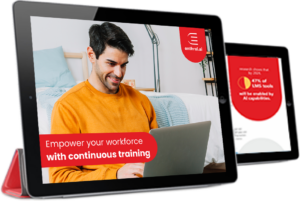How Skilling Programs Help Performance Management

Skilling and learning are integral aspects of job performance, particularly for knowledge workers.
As organizations work to enhance employee capabilities and drive productivity, skilling programs play a key role. These initiatives are essential not only for equipping employees with the necessary knowledge, but also for aligning with performance management objectives.
In this blog, we’ll look at how skilling programs contribute to effective performance management strategies, bridging the gap between learning and achieving organizational goals.
Importance of Skilling
Any business that is unable to evolve and adapt will likely fail. Similarly, a company whose employees aren’t learning risks stagnation. To succeed, organizations need to cultivate a culture that promotes employee learning and embraces performance management.
Encouraging a learning culture that helps build skills and knowledge offers two-fold benefits. Firstly, employees become more valuable to the company as their abilities enhance. Secondly, individual growth helps employees move ahead in their careers, contributing to retention and job satisfaction.
Continuous upskilling is crucial to stay updated on technological advancements in virtually every industry. To remain competitive, companies need employees who are adaptive and ahead of the curve. Establishing a culture of learning and skilling is a significant long-term investment with rewards that far outweigh the effort.
Importance of Performance Management
Performance management is an equally crucial area as it aligns employee performance with organizational goals. Effective performance management systems include key components such as Objectives and Key Results (OKRs) and Key Result Areas (KRAs).
These frameworks ensure that individual objectives are in sync with the company’s vision and provide clear targets for employees. Regular appraisals are essential to evaluate employee performance, providing critical feedback and enabling decisions on promotions and compensation. Robust Rewards and Recognition (R&R) programs are also necessary to boost employee morale and motivation by acknowledging their contributions. Continuous feedback and coaching further support employee development so that they remain engaged and capable of meeting evolving business needs.
Strategic Approach to Skilling for Performance Management
Now, enhancing employee performance requires a strategic approach through skilling. This means recognizing that gaps in knowledge or skills may reflect larger organizational needs or challenges. Besides, not all of it can be remedied by standard training programs.
Effective performance improvement calls for a holistic view that begins with a clear understanding of the organization’s business objectives and needs.
This includes:
- Assessing existing skills within the organization and identifying which teams/individuals possess them
- Anticipating future needs and identifying any skill gaps that may arise
- Designing learning journeys to maintain current skills and develop future ones
Savvy learning leaders align these objectives with broader performance management goals. These could include employee retention, career development or even identifying future leaders. They also collaborate more closely with HR teams to ensure synergy in learning strategies.

Empower your workforce with continuous training
- Employee Onboarding
- Employee Upskilling
- Compliance Training
Benefits of Integrating Skilling and Performance Management
By now, we have established that skilling and performance management are linked. However, understanding how these concepts complement each other might still seem abstract.
Let’s look at some real-world examples to understand why it’s important to integrate both areas:
Career Development and Performance Improvement
Integrating skilling and performance management supports career development and performance improvement. For example, an employee aiming for a managerial role can be assessed to identify skill gaps with targeted training provided to address these gaps. This enhances their growth and aligns with company goals.
Performance management systems highlight areas needing improvement such as proficiency with a specific tool. Skilling initiatives then provide necessary training, leading to better performance and increased productivity.
Moreover, this integration ensures employees are future-ready. Companies can offer training for anticipated changes like digital transformation, while performance management tracks progress. This makes employees future-ready.
Goal Alignment and Employee Performance
Integrating skilling and performance management ensures that skill development programs align with the company’s strategic objectives. By identifying the specific skills required to achieve business goals, organizations can tailor training programs to develop these competencies. This alignment ensures that individual efforts contribute effectively to the overall strategy.
For instance, if a company’s goal is to innovate its product line, developing employees’ skills in areas like design thinking or advanced engineering directly supports this objective. When employees are equipped with the right skills, their performance improves, impacting the company’s ability to achieve its business objectives.
Employee Engagement & Satisfaction
Surprisingly, one of the most significant outcomes of integrating performance management and skilling is employee satisfaction. We no longer live in an era where annual performance reviews resemble competitive game shows where employees receive scores pitted against their peers.
Modern performance management focuses on collaborative support rather than just metrics and competition. To nurture employee satisfaction, it is important to offer quality skilling opportunities that help individuals excel in their roles.
The truth is, people thrive on learning, especially when it enhances their personal growth and career advancement prospects.
8 Best Practices for Implementing a Performance Management Program Grounded in Skill-Development
1. Specify Objectives
Effective skilling and performance management hinge on clear objectives. Collaborate with employees to set achievable goals tailored to their roles. Ensure alignment with industry trends and company needs. Don’t forget to consider individual performance and organizational objectives.
2. Align Learning with Goals
Ensure that learning initiatives are tailored to specific roles and that they contribute to organizational objectives. Align employee development with overall business goals to maximize the impact on company success.
3. Provide Support
Offer support as needed to help employees achieve their goals. This may include on-the-job training, social learning platforms or direct guidance. Continuous skilling and learning opportunities help in growth and development for both individuals and the organization.
4. Embrace Competency-Based Learning
Implement competency-based learning practices to enhance performance management Competency-based learning focuses on developing specific skills and behaviors directly linked to job performance. By identifying key competencies required for various roles, organizations can create targeted learning programs that ensure employees acquire these essential skills.
5. Build a Culture of Continuous Learning
Encourage a culture of continuous learning and development at all levels of the organization. Embrace diverse learning approaches that suit both employees and the company, fostering continuous skill enhancement.
6. Offer Regular Assessments & Feedback
Conduct regular assessments and provide constructive feedback to employees. This helps in identifying skill gaps and areas for improvement, ensuring continuous development and alignment with organizational goals.
7. Provide Rewards & Recognition
Implement a robust rewards and recognition program to acknowledge employees’ achievements. Recognizing and rewarding efforts boosts morale and motivation, driving higher performance and engagement.
8. Incorporate Gamification
Incorporate gamification techniques to make learning and development more engaging. Using game elements like points, badges, and leaderboards can motivate employees and enhance their learning experience, leading to better performance outcomes.
Wrapping Up
Learning and performance go hand in hand.
Enhancing performance often involves on-the-job learning or external upskilling. Although factors like effort and timeliness can influence specific aspects of performance, it is skills and knowledge that typically determine the value and direction of employees.











